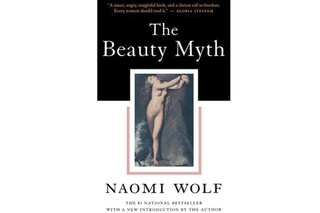
Revisiting ‘The Beauty Myth’: What Are the Ethics of Applying Bad Facts to a Good Cause?
The message of oppressive beauty standards in Naomi Wolf’s feminist classic remains relevant, though faulty statistics plague its credibility.

Naomi Wolf’sThe Beauty Myth: How Images of Beauty Are Used Against Women has long been heralded as one of the greatest feminist books written. Many women have confessed that Wolf’s book was the antidote that woke them from the thrall of advertising, glamour and the intense need to conform to physical perfection. Although revolutionary in its prose and critical analysis, Wolf’s book fails at one vital juncture: accuracy.
In The Beauty Myth, Wolf argues that the standard of beauty and feminine traits assigned to women are devaluing. Women from all walks of life cannot seize power and happiness completely, because their insecurity at personal appearance — while bombarded by brands, fashion editorials, and pornography — is so profound that it mentally pulls them back. Wolf writes, “The real issue has nothing to do with whether women wear makeup or don’t, gain weight or lose it, have surgery or shun it, dress up or down, make our clothing and faces and bodies into works of art or ignore adornment altogether. The real problem is our lack of choice.” It was a groundbreaking idea for its time.
However, a problem regarding the book reemerged during a recent controversy that Wolf encountered while publicizing her new book, Outrages, a documentation of Victorian-era same-sex relationships and their persecution. While Wolf was explaining how the last recorded execution for the above was misreported as 1835, host Matthew Sweet interjected saying, “Several dozen executions? I don’t think you’re right about this.” He then went on to disprove this key element in Outrages by both pointing out that ‘deaths recorded’ was the Victorian Court term for pardons, and that the term ‘sodomy’ used to record these crimes was then applicable for both same-sex relationships and child abuse. Sweet added, “I can’t find any evidence that any of the relationships you describe were consensual.”
Though Wolf took it in her stride and corrected the above in her book, she has always had a problem with facts and statistics, often manipulating both to put across her point in a stronger manner. The Beauty Myth is no stranger to such manipulation, with Wolf having exaggerated statistics about anorexia — for example, stating around 7.5% of the total girls and women in the U.S. had anorexia, when the actual percentage was 0.065. So fraught was the book with incorrect statistics that there exists a critical research paper titled, “A Critical Appraisal of the Anorexia Statistics in The Beauty Myth: Introducing Wolf’s Overdo and Lie Factor (WOLF),” which, in its abstract, states that “18 of the 23 statistics (regarding anorexia nervosa) are inaccurate and overdone” and that “on average, a statistic on anorexia by Naomi Wolf should be divided by eight to get close to the real figure.”
Related on The Swaddle:
What Keeps Many Girls from Loving Their Bodies
This sort of fact-fudging is both patronizing and harmful. One one hand, Wolf infantilizes her mostly female readership by using numerous anorexia deaths as the great specter that would change their minds. On the other, it perpetuates the idea that people only fear diseases that reach epidemic proportions. Would a doctor show any less concern for a rare disease with terrifying implications? Wolf didn’t need to create an epidemic when the nature of the disease itself has always been bone-chilling. How could a potential survivor of anorexia, who also found solace in The Beauty Myth, come to terms with the use of her illness and trauma to fearmonger?
Other statistics in Wolf’s book haven’t fared too well either. In the 1991 review of The Beauty Myth, New York Times critic Caryn James points out that Wolf’s statistics were both dubiously sourced and dated. James wrote, “She makes the preposterous claim that in the United States only 48 percent of women use contraception regularly, her source is a 1984 pop-psychology book called Swept Away: Why Women Confuse Love and Sex. And who knows where those old numbers came from?”
Fact-checking isn’t the only problem with the book, which continues to grace budding feminists’ shelves. In the new introduction for the 2002 edition of The Beauty Myth, Wolf writes that “the latest fashions for seven and eight-year-olds recreate the outfits of pop stars who dress like sex workers.” The idea that children (or anyone) can be ‘sexualized’ by virtue of how they dress and the implied derision for sex work is oddly placed in a book about the corporatization of feminine beauty and insecurities, making it dated and insensitive.
Related on The Swaddle:
New Study Sheds Light on Genetic Causes of Anorexia
Ironically, a similar conclusion was drawn in the 1991 review of the book. Caryn James wrote, “(Wolf) examines how women’s magazines have substituted the impossible ideal of youthful beauty for the pre-feminist goal of a clean house and domestic bliss. But she writes as if women’s magazines were as powerful today as they were in the 1950s. More damaging, she virtually ignores how television, film, and videos have shaped women’s self-images and their bodies. How can any credible analysis of the way beauty tyrannizes women afford to ignore Oprah Winfrey’s liquid diet, Jane Fonda’s mega-hit exercise tapes or Madonna’s ever-changing sexual parade?”
Though Wolf acknowledges her inaccuracies, she ignores criticism. In a recent interview with The Guardian, she said, “I’m lucky. I had a good education. I know my books are true. They’re well sourced. They have hundreds of footnotes,” while fully aware of the various ways in which her research methodology has been picked apart over the years. Maybe, a reason to disregard criticism could be the confidence derived from Wolf’s privilege. (She came from a family of academics, read literature at Yale and was a Rhodes Scholar at Oxford University.) Someone with a more marginalized identity would’ve never found continued backing from publishers after a scandal like this.
Another reason could possibly be the lure of a larger cause. In the New York Times’s review of Outrages, critic Parul Sehgal writes, “The issue (with writers who misrepresent information) isn’t simply that publishers don’t spring for fact-checking and leave writers vulnerable to making such errors. These writers see themselves in service of something larger than grubby reporting. They are the emissaries of great stories, suppressed stories, and if they take liberties or eschew careful research — as consistently as Wolf has done — it is because they believe they have a right to them, that the story, the cause, somehow sanctions it.”
The cause makes the ethical implications of Wolf’s misrepresentation murkier. While any scholar worth their salt would place no value upon this book, the women who read and swore by it still do. This is because The Beauty Myth’s cause has been that of the greater good — which makes it harder to dismiss entirely. Wolf’s observations – about women embodying beauty and men wanting to possess it; about the onus of beauty landing squarely on women’s shoulders — are all subjectively accurate and relatable. This discrepancy of false facts and subjective truths make Wolf look like some sort of feminist vigilante, trying any means necessary to get her point across, rather than the academic she’s branded herself as. In a world where women have to work twice as hard to be taken as seriously as their male counterparts, this doesn’t bode well — especially for feminist scholarship.
As children, we learn facts about the world around us and later grow up to realize that particular nuances of said facts may be incorrect. For example, we all learned as children that chameleons change color to camouflage themselves when the actual reason why they do so is a representation of mood and a change in body temperature. Perhaps, The Beauty Myth is a similar sort of primer: a solid exposure to critical feminist theory at a young age, that is best left behind slowly as one gathers more nuance and appreciation for facts.
Aditi Murti is a culture writer at The Swaddle. Previously, she worked as a freelance journalist focused on gender and cities. Find her on social media @aditimurti.
Related


NIFT Fires 56 Women To Protect One Man Accused of Sexual Harassment
